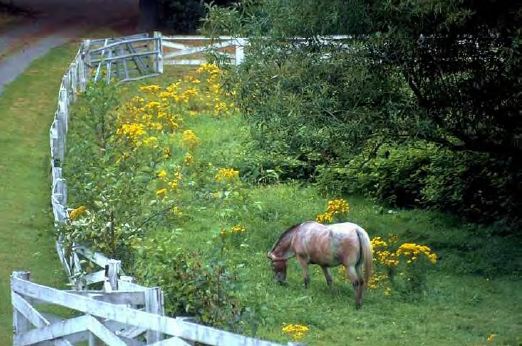When my sister and I pulled together to buy our farm several years ago, it was a complete mess. I remember pulling up to the drive and making the comment “There’s a house back there?” There was basically a roof visible from the road that rose up from behind a solid wall of hedges that stretched across the front of the house.
And then there was the backyard — oh geez. We affectionately nicked our new property “The Wilderness,” and it felt like we were waging war against Mother Nature. I could see the potential underneath all of the junk … a nice, mostly flat piece of open ground that was over six acres. It would be perfect to set up for the horses. You know, after we got rid of all of the bramble bushes. And old, rotted fencing. And sheds. And boat trailers. And swing sets. Need I go on?
Anyway, once we got the property under control, the next step was getting the pasture fencing up. Most of the ground had so many weeds that we enlisted the help of our farmer neighbor to plow everything up and re-seed grass. However, with the timing of needing to move the horses in, we had to pick and fence in an area for our main pasture.
Fortunately, we spent a total of three months in the dead of winter working to get the property ready for the horses, so weeds were not an issue. At least until the weather warmed up. With the presence of many difference weeds, I did two things. First, I invested in an illustrated guide book of plants toxic to horses. And second, I treated the entire pasture with a weed spray that was safe for that purpose.
Do you know what common weeds in your pasture look like? And, more importantly, can you identify those that are toxic to your horses? Head over to The Horse to check out a helpful illustrated slideshow of common pasture weeds. You can check it out here.
And then read up on some of the other headlines from this week in Horse Health News, presented by Absorbine.
Between Farrier Visits: Most of us know the every six-to-eight week schedule quite well — it’s generally that amount of time between visits from someone who is oh-so-very important to keeping our horses sound and their hooves well cared for. Are you familiar with some of the maintenance tips for keeping your horse’s hooves looking great in between farrier visits? [Equine Wellness Magazine]
Why Might My Horse Stumble? If you notice your horse stumbling in (or out) of the ring, it is something that shouldn’t be ignored. While stumbling could be a training issue, it could also be the result of a physical cause. Read up on some of the different physical causes of a stumble — why they happen and what you can do to stop them — here. [Practical Horseman]
Does Electric Fencing Cause Stress? Do horses actually get stressed out by being around active electric fencing? The answer, according to Swiss researchers, is it does not. After looking at both small and large fenced in areas, there was no evidence found of stress responses given by horses confined by electric fencing. [Horsetalk]
Horse Treat Safety: What kind of treats do you feed your horses? While my horse Ripley has always favored apples, I’ve always heard to be mindful of not feeding him too many at one time, so he gets only one apple per day. Are other fruits (and vegetables) safe to feed as treats? And are there any you should avoid? Find out here! [Horse Channel]
Beer and Horses? I once was told by an old trainer that beer could be given to horses who needed to sweat more (which explained the presence of a case of Guinness in the tack room at a barn where the riders were almost exclusively teenage girls). Is there really a purpose of giving beer to a horse? And what kind of impact does it have on your horse? [Practical Horseman]




















